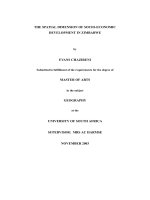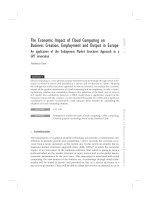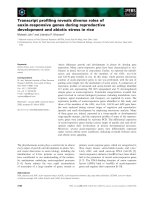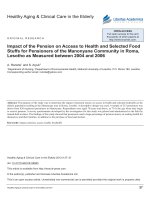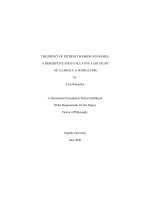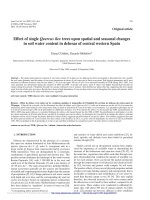Identification of the Barriers in implementing Decision No. 79/2005/QĐ-TTg of prime minister on socio economic development and national defense and security for the Northern midland and
Bạn đang xem bản rút gọn của tài liệu. Xem và tải ngay bản đầy đủ của tài liệu tại đây (121.72 KB, 9 trang )
VNU Journal of Science: Policy and Management Studies, Vol. 32, No. 1 (2016) 13-21
Identification of The Barriers in Implementing
Decision No. 79/2005/QĐ-TTg of Prime Minister
on Socio-Economic Development and National Defense and
Security for the Northern Midland and Mountainous Region1
Vũ Cao Đàm*
Institute of Policy and Management, VNU University of Social Sciences and Humanities,
336 Nguyễn Trãi, Thanh Xuân, Hanoi, Vietnam
Received 25 January 2016
Revised 02 March 2016; Accepted Accepted 14 March 2016
Abstract: Barriers to the implementation of Decision No. 79 should be considered from a
systematic approach. (1) The most important barrier is in Decision No. 79 itself, showed by the
development of only infrastructure, unclear objectives of economic and social development; (2)
Barriers at macro-level management, manifested in the absence of the direction of the macromanagement agencies; (3) Barriers at micro-level management, demonstrated by proactive
implementation and scattering target; and (4) Barriers from economic environment and social
policy are the dispersion of resources on the target that is not to develop the Northwest.
Keywords: Barriers, systems approach, implicit restriction, indicator, Macro, Micro, Environment
1. Introduction∗1
has been promulgated for ten years, but we still
continue raising the research question to
“overcome the barriers in implementing
Decision No. 79”. Although there is no detailed
analysis under evaluation indicators, we can
boldly bring out the logical inferences, to
explain why the basic content of Decision No.
79 has not gone into life.
Certain barriers make it difficult for good
intentions of Decision No. 79 to come into life
smoothly. Therefore, within the framework of
the project “Research, reviewand assessment of
the results, impacts and proposal of solutions to
effectively
implement
Decision
No.
79/2005/QD-TTg of the Prime Minister, Code:
KHCN-TB.02X/13-18”, it is the requirement to
Decision No. 79/2005/QD-TTg (Decision
No. 79 for short) is a very important document
to implement the Party's policies on socioeconomic development for the Northwest
region. However, until now Decision No. 79
_______
∗
Tel.: 84-966628704
Email:
1
This article is the result of the state-level project titled
"Results and impacts assessment and proposal of solutions
to effectively implement Decision 79/2005/QD-TTg of the
Prime Minister” - Code: KHCN-TB.02X/13-18, under
the framework of the state-level key science and
technology program in the 2013 – 2018 period titled
"Science and Technology for the Sustainable
Development of the Northwest Region", VNU
13
14
V.C. Đàm / VNU Journal of Science: Policy and Management Studies, Vol. 32, No. 1 (2016) 13-21
research and find the solutions to overcome the
barriers in implementing Decision No. 79.
2. The theoretical framework of barriers
It is needed to clarify the definition of a
barrier. What are the barriers to the
implementation of a good policy on
development for the Northwest?
The concept of barrier can be understood
widely. We limited the understanding to unify
preliminarily the identification of the barriers
and solutions for those barriers.
1) The concept of barrier
Literally barrier is a physical fence that gets
in the way, slows and stops progress through a
certain limit. We call it visible barrier.
Then the barriers to the implementation of a
work, a guideline, or a policy can be understood
as the non-physical barriers that hinder the
implementation of that work, guideline or
policy. We call it invisible barrier, for example
awareness of the inadequacies, since the
instruments do not match with the objectives of
the policy, or the implementer does not abide
accidentally or intentionally.
2) Classification of barriers
In this article, we only discuss about the
invisible barriers. The invisible barriers include
many types, which are:
(1) The internal implicit institutions that
existed in the document impede the
implementation of good guideline and
policy that are expressed in the objective
section of the document. This is a common
mistake in the policy documents of our
country.
(2) The barriers belong to an error in the
stage of organizing and directing the
implementation at macro-level: either
ignoring the stage of organizing and
directing the implementation at the macrolevel; or the stage was suffered from
undesired impacts, led to the disablement
of policy announced.
(3) The external implicit institutions that
existed in other documents impede the
implementation of good guideline and
policy that are expressed in the
considerable documents. The external
implicit institutions are very wide; they
exist in all the areas, sectors and localities.
(4) The barriers belong to an error in the
stage of implementation at micro-level:
Micro-level is the grassroots level where
receiving and implementing policies. We
can see that either micro-levels do not
organize the stage of implementation well;
or the capacity of implementers is not
qualified enough.
3) Indicators for the identification and
evaluation of the barriers
The indicators are formed according to
these four types of barriers above:
(1) Indicator 1: The internal implicit
institutions that existed in the document
itself in Decision No. 79.
(2) Indicator 2: The ability to direct for
the implementation at macro-level, in
which this is the direction and guidance of
the
ministries/agencies
on
the
implementation of Decision No. 79.
(3) Indicator 3: The external implicit
institutions that exist in relevant, indirect
documents of Decision No. 79 but have
impacts on the implementation of Decision
No. 79.
(4) Indicator 4: The ability to implement
at micro-level is the ability to implement in
localities of the considerable areas in
Decision No. 79.
The above indicators are mostly qualitative
assessment.We have carefully considered that
in fact it is impossible and unnecessary for
quantitative assessment.
3. Analysis of barriers under the indicators
This section, we use the proposed indicators
to identify and analyze all types of barriers.
V.C. Đàm / VNU Journal of Science: Policy and Management Studies, Vol. 32, No. 1 (2016) 13-21
3.1. Indicator 1. Analysis of barriers that exist
inside the documents
This analysis is under indicator 1 on the
intrinsic default institutions that exist in
Decision No. 79. This barrier is considered to
be the most important barrier and will be
analyzed as follows.
3.1.1. The Content of Decision No. 79
In the first seminar of the project dated on
25/01/2015, we had a presentation about the
internal implicit institutions, but at that time we
have not used this concept yet. This concept is
formed after a process of research.
We have reviewed the entire 54 missions
that are mentioned in Decision No. 79 and
divided as follows [1]:
(1)
Reviewing,
adjusting,
and
supplementing the overall planning on socioeconomic development, planning on sector
development, attaching the planning to the
five-year 2006-2010 plan.
This part brings up 24 missions on
reviewing the overall planning on socioeconomic development and planning on sector
development, attaching to the five year plan,
from 2006 to 2010. These plans revolve around
the following contents:
- Overall regional planning, including
specialized cultivation regions
- Overall sectoral planning, including
industrial and agricultural products
- Planning on economic development for
the Northern border regions
- Urban planning; rural planning
- Electrical network planning; traffic
planning
- Planning on telecommunications and
broadcasts network
- Planning on security system
The contents mentioned above are actually
orientations for the relevant agencies to carry
out the plan. Meaning that, after the publication
of Decision No. 79, a certain agency will be
15
assigned to organize the planning, but through
the surveys that we have participated in the
framework of the project, we have realized
that, there are no agencies which have been
assigned for the implementation of this work.
(2) In term of investment projects for the
construction of socio-economic infrastructure
Decision No. 79 specifies 12 missions on
the projects of infrastructure development
- Investment preparation for highway
projects: Lang Son - Bac Giang - Hanoi Viet Tri; the railway sections that connect
industrial centers to major mining centers
in the region;
- Building some traffic routes that links
the provinces of Cao Bang - Lang Son Thai Nguyen - Son La – Vinh Phuc;
- Building some railway routes, for
example, Yen Vien - Cai Lan; increase
the capacity of the Northern route;
upgrading the existing routes in the area:
Hanoi - Lao Cai, Hanoi - Lang Son,
Hanoi - Thai Nguyen, Kep – Luu Xa;
- Renovating and upgrading a number of
river ports and main river routes of the
region;
- Building a series of irrigation works and
water transport systems which will serve
hydropower projects;
- Building project on protection and
restoration of protection forests in Da
River Basin;
- Renovation and new construction of
water supply facilities for production and
daily life of the urbans;
- Development ofthe financial services,
banking, import, export, post and
telecommunications;
- Project on gate economic zones,
shopping mall, wholesale markets of
agricultural
products,
seafood.
Construction of infrastructure in gate
economic zones;
16
V.C. Đàm / VNU Journal of Science: Policy and Management Studies, Vol. 32, No. 1 (2016) 13-21
- Construction of infrastructures in
industrial zones along the Yunnan - Lao
Cai - Hanoi - Hai Phongcorridor, the
Lang Son - Bac Giang - Hanoi corridor
and the Hoa Binh - Son La - Dien Bien Lai Chau corridor;
- New construction, expansion and
upgrading of universities, colleges, ethnic
boarding and vocational schools, medical
facilities, and addiction recovery centers;
- Construction of regional medical centers
in Thai Nguyen and Son La; upgrading
the infrastructure and equipment for
district hospitals and commune health
stations;
- Implementation of cultural development
projects in particularly difficult provinces
at the Northern mountains (Ha Giang,
Cao Bang, Lao Cai, Lai Chau, Dien Bien,
Son La);.
- Implementation of investment projects
to build socio-economic infrastructure for
difficult communes, border communes,
safety communal areas and commune
cluster along the Vietnam-China and
Vietnam–Laos borders.
Through our direct surveys, except for
highway projects which were implemented
by the ministries before Decision No. 79, all
the results show that, the localities have not
received any guide documents of the
ministries/agencies about the missions
related to the content of Decision No. 79 as
mentioned above.
(1) In term of manufacturing projects for
main products
In Decision No. 79, there are 4 missions on
the production of main products. Analyzing
those four missions, we realized that some
specific tasks produce the following products:
- Cultivating specialty plants and raising
animals that have the competitive advantages
in consumer markets and forming the focus
commodity production, in association with
industrial processing facilities;
- Aquaculture concentrates in reservoirs
and produces specialty seafood with the
scale from 30 - 50 hectares or more across
the region;
- Speeding up the construction and
rehabilitation projects for cement
factories,
- Expanding Cam Duong Apatite Ore
Sorting Factories (Lao Cai) with the
capacity of 100,000 tons/year;
- Expanding manufacturing factory of Bac
Giang Nitrogenous Fertilizer;
- Investing in Bac Nhac Son Apatite Ore
Sorting Factories (Lao Cai) with the
capacity of 350,000 tons/year; Thai
Nguyen Cement Projects with the
capacity of 1.5 million tons/year.
- Speeding up the construction project of
Steel Rolling Factory (with the capacity
of 300,000 tons/year) of Thai Nguyen
Iron and Steel Company, Nguom Trang
Irons Mining (Cao Bang); renovating cast
iron stove to increase the capacity of steel
billet to 750,000 tons/year.
- Speeding up the implementation of the
complex project, including: Sinh Quyen
(Lao Cai) with the capacity of 10,800
tons/year, Thai Nguyen electrolytic zinc
with capacity of 10,000 tons/year, irons
mining: Quy Sa (Lao Cai).
- Speeding up the expansion of Bai Bang
Paper Factory phase II: new construction
of investment projects on Thanh Hoa Pulp
and Paper Factory with the capacity of
60,000 tons/year.
Beside these production projects, the
documents of Decision No. 79 also mention the
energy production projects, as follows.
- Taking Son La hydropower project into
operation earlier than the prescribed time
limit. This project was made before
Decision No. 79.
- Performing the immigration and
resettlement in sync with the progress of
construction works.
V.C. Đàm / VNU Journal of Science: Policy and Management Studies, Vol. 32, No. 1 (2016) 13-21
- Ensuring the construction progress of
Tuyen Quang hydropower project (Na
Hang hydropower project);
- Developing irrigation in combination
with hydropower.
All these sections in fact have been put into
planning before Decision No. 79 and the
relevant ministries have been assigned directly
from the Government, there is no relationship
with
the
Steering
Committee
for
implementation of Decision No. 79.
(2) Improvement of the policies
This section outlines 14 missions, including
the contents on promulgation of the policy to
serve the development projects in the
Northwest, in which set the task to review the
current policy, construction research and
promulgation of new policy for the provinces in
the Northern midland and mountainous region.
We divided into the following types of policies:
1) Construction of specific policy
framework for socio-economic development in
the Northern midland and mountainous region,
submitted to the Government in the fourth
quarter of 2005:
- Special incentives to attract foreign
investment, strengthen cooperation with
China and Laos;
- Border economic policies, created a
stable source of export goods across
borders, strengthen economic cooperation
with China and Laos;
- Management of border protection, the
use of capital, integration of the national
target program with the border protection
funds;
- Management and rational allocation of
budget funds for the local;
- Signing of the Agreement between
Vietnam - China and Vietnam - Laos on
building a system of cross-border traffic;
- Supporting and incentives policy to
encourage industrial development at the
northern midland and mountainous
region;
17
- The policy for improving the method of
the distribution of agricultural products,
develop markets;
- Special incentives policies and
encourage to invest in research and
technology transfer in the Northwest.
2) Development Policies for Specific
Seedlings
- Policy for encouraging the research and
production of crop varieties, and high-quality
fish farming
- Policy for encouraging the development of
aquatic strains and development policy for
aquaculture areas of focused specialty
3) Development Policy for Resources:
- Developing vocational training and job
creation for poverty reduction, social
security and detoxification in Northern
midland and mountainous provinces,
especially for ethnic minorities.
- Human resources training for the
Northern midland and mountainous areas,
implementation of scholarships for
boarding students in public schools, semipublic school.
- Financial support for healthcare fund of
the poor in Northern areas, more efficient
coordination for military health care and
protection at the border provinces and
special treatment for healthcare workers of
sustainable border.
- Policies support, promote and encourage
the
development
of
postal
and
telecommunications infrastructure and
Internet facilities in Northern midland and
mountainous provinces.
- Strengthening the organization, such as
decentralization of local authorities to
improve the autonomy and creativity in
management and administration.
4) Preventing activities that affect security,
politics, social order and safety such as:
fighting drug abuse, prostitution and trafficking
of women across the border on the key areas of
Northern midland and mountainous region.
18
V.C. Đàm / VNU Journal of Science: Policy and Management Studies, Vol. 32, No. 1 (2016) 13-21
Through interviews and discussions that we
have made in the surveys, we came into a
conclusion that all the reports on the activities
implementing Decision No. 79 are made by
localities themselves; no policy has been
announced for the deployment of the policies
listed above.
Thus, we can fully recognize, the steering
activities for policy completion to deploy the
implementation of Decision No. 79 is not taken
seriously.
3.1.2. The problem based on the systems
approach
From the analysis of 54 tasks outlined in
Decision No. 79, we only see two contents on
the production of special products in
agriculture, forestry and fisheries in the
localities, but they have only been in the
“research project formulation” phase to
produce plans for a future that has not been
determined yet.
Based on the Decision No. 79, we fully
recognized that there are only those few
projects. All remaining tasks revolve around the
following items:
1) Construction of infrastructure, such as
railways, roads, waterways, and ports.
2) Ensure the power sources for the
production and irrigation water of agriculture.
3) Develop and upgrade training and
medical facilities.
4) The system of services for businesses.
5) Improving the policy to implement the
aforementioned tasks.
Thus, the assessment of the implementation
of Decision No. 79 will aim to:
1) First of all, the formation of industry and
agriculture characterized by region. Studying
Decision No. 79, we can see that this goal is
very thin. Nevertheless it is likely that
Ministries and localities have implemented
well, but the survey results show none of that.
2) Secondly, the infrastructure system to
ensure the production of those industries. This
section accounts for the main contents of
Decision No. 79. From systematic approach, we
have not found a relationship between the
preparation of infrastructure and the
development goals.
3) Third is the policy to ensure the
operation that serves the development goals.
From the above analysis, we boldly made
the following comments:
Overall, we can imagine that Decision No.
79 is a draft program preparing for development
strategies in the Northwest region, rather than a
development program.
3.1.2. Preliminary identification of Decision
No. 79
From the analysis presented in Part II and
Part III, we noted the following points:
Firstly, if this decision is considered as a
preparation for a development strategy, the
consideration will be toward the evaluation of
the preparing results:
+ Preparing development projects.
+ Preparing the infrastructure.
+ Preparing the policies.
If it is considered from the approach of a
preparation development project, perhaps, an
inevitable question will be in which
development goals are these preparations for?
This is unclear in the document of Decision
No. 79.
If it is seen as a development platform, it is
necessary to clarify the development goals,
such as:
+ First of all are the social objectives.
Which level of social development can be
reached?
+ Economic objectives must clearly indicate
what products, which level of development can
be reached, and the consumer market of those
products.
+ With this existing development goals to
ensure the energy resources?
V.C. Đàm / VNU Journal of Science: Policy and Management Studies, Vol. 32, No. 1 (2016) 13-21
+ The target market for the product
considering the conditions of the infrastructure.
+ With all of the above requirements for
development, it is necessary to continue
researching policies to ensure the development
goals according to the premium plan.
Of all the approaching options, we can
strongly identify that, Decision No. 79 is not
eligible for the above two possibilities.
3.2. Indicator 2. Steering at the macro level
We use two approaches for evaluation
under this indicator:
1) Firstly, we searched in the Government
Gazette2, and then realized; only the Ministry of
Planning and Investment has written an
implementation guide of the Decision No. 79.
2) Secondly, the interview results in several
localities show that they did not receive any
guidance circulars of Ministries, except for the
Ministry of Planning and Investment [2].
3.3. Indicator 3: External implicit institution
Evaluating the effects from the perspective
of border security related to Northwest region
on the implementation of Decision No. 79,
analysis of potential problems in the document,
both positive and negative, in the arrangement
of the categories shows that:
Field of industrial development
The industrial projects have impacts on
many aspects of border security, including
positive effects and negative effects.
The construction of hydropower plants built
too close with each other will make it difficult
for water distribution, affecting energy security;
at the same time will depend on China on the
volume of water in Hydropower Lake
inupstream rivers that flow from this country.
To make the hydropower plants, forests are
destroyed in many places, water pollution was
quite severe in some places, threatening the
sustainability of agricultural development.
Displaced people in large numbers, leading to
guaranteed life more difficult, especially in the
_______
2
Government Gazette, 2005-2010
19
mountainous, remote and border areas, etc. are
the complex causes of security and social order;
crime rate will rise.
Field of agriculture, forestry, and irrigation
works
The irrigation works are invested and
exploited inefficiently, led to the regulation of
water for agriculture on the season was not
good; people moved to places that are favorable
for farming or deforestation for agriculture.
That affects a lot to border security, people may
have to go across the border (China) for
employment or lease farmland in Laos. When
having troubles in life, the crimes become more
rampant, especially drug crime; hire shipment
of transport drugs from foreign countries into
Vietnam.
Field of road traffic
Convenient transportation, facilitating the
exchange of goods between regions, income
from cultural activities and tourism, especially
in moving maneuver forces for national defense
when required.
However, transport development also
created hotspots in security and social order:
Drugs, smuggling and abuse of national
security.
Besides, illegal trafficking of drugs
developed with convenient transportation,
smuggling becomes mobile, fast and powerful.
With the consequences of drugs, security and
social order in the Northwest border become
more and more complex.
On the other hand, although having large
investment, the border patrol is still slow, with
low quality and below expected efficiency.
Also, if there is the presence of war,
enemies will also have the conditional mobility
to attack us faster
Other unexpected possibilities
The program of population stabilization by
Decision No. 79 also raises many complex
issues. When life is hard, people will compare
with their kin living across the border
20
V.C. Đàm / VNU Journal of Science: Policy and Management Studies, Vol. 32, No. 1 (2016) 13-21
(especially China). Cross-border employees are
developing in the minorities in our country. On
the other hand, China will continue to increase
"black" cultural venues and gambling dens in
the gate area to attract tourists [3].
Ethnic relations across borders, their culture
will affect the culture of the ethnic groups in
our country, especially ethnic groups near
Chinese border. Culture can also act in a
negative direction, such as differentiating
communities, abetting social ills.
3.4. Indicator 4. Implementation steering of
Decision No. 79 at the micro level
From the working results in all the places
gathered for the study including the reports
received, we come to the realization that
localities have implemented Decision No. 79 by
themselves,
Most of them did not receive a written
guidance from the macro level, meaning the
ministries/departments/branches, whether they
are Party committees or Government
departments.
From here we come to the realization, that
the localities were very creative in
implementing Decision No. 79.
from a poor backward country (with
$100/person) to leading industrialized countries
in Asia.
We mentioned the events above to convey a
message about the delay in the implementation
of Decision No. 79, and important barriers,
described at the macro level.
5. Conclusions and recommendations
1) With the above analysis, I think that the
barriers for the implementation of development
goals and the means for development outlined
in Decision No. 79, including policy barriers
are at macro level.
2) Results of the implementation of
Decision No. 79 probably only in the
development of infrastructure. It could be
double-edged sword, when the enemy leverages
that infrastructure to harm the national security
of our country.
3) The immediate problem is the need to
focus on understanding the Northwest
Development Goals by Decision No. 79, so that
the northwestern provinces can achieve
powerful development, and worthy of a
strategic area on the junction of three countries:
Vietnam - Laos - China.
4. Remedy of barriers
From the analysis of barriers according to
the indicators above, we can identify
preliminarily a reality that is barriers at the
macro level are the most important ones.
Ten years since the issuance of Decision
No. 79, from 2005 to 2015, is not a short time.
We can recognize from the history:
- Ten years from 1981 - 1991, with
Directive 100/BBT on assigning products to
households and workers, Vietnam has changed
from a poor country to a ranked rice exporting
country in the world
- In Korea, ten years since Pak Chung Hee
was in power, from 1961 - 1971, it has changed
References
[1] Prime
Minister
(2005),
“Decision
No.
79/2005/QD-TTg of April 15, 2005, promulgating
the Government's Action Plan to implement the
Political Bureau's Resolution No. 37-NQ/TW of
July 1, 2004, on orientations for socio-economic
development and assurance of defense and
security in the Northern midland and mountainous
region up to 2010” (Action Plan attached).
[2] Reports on the implementation status of Decision
No. 79/2005/QD-TTg in 9 provinces of the
Northwest regions (2014-2015), project’s surveys.
[3] Project thematic No. 88: Solutions to enhance the
efficiency of the implementation of Decision No.
79/2005/QD-TTg on border issues in Northwest
provinces.
V.C. Đàm / VNU Journal of Science: Policy and Management Studies, Vol. 32, No. 1 (2016) 13-21
21
Nhận diện rào cản trong việc thực hiện Quyết định
số 79/2005 / QĐ-TTg của Thủ tướng Chính phủ về phát triển
kinh tế xã hội và an ninh quốc phòng cho các vùng trung du
và miền núi Bắc Bộ
Vũ Cao Đàm
Viện Chính sách và Quản lý, Trường Đại học Khoa học Xã hội và Nhân văn,
336 Nguyễn Trãi, Thanh Xuân, Hà Nội, Việt Nam
Tóm tắt: Rào cản thực hiện Quyết định 79 cần được xem xét từ từ tiếp cận hệ thống. (1) Rào cản
quan trọng nhất nằm trong bản thân Quyết định 79, thể hiện ở chỗ, mới quan tâm phát triển cơ sở hạ
tầng, chưa rõ mục tiêu phát triển kinh tế và xã hội; (2) Rào cản ở cấp quản lý vĩ mô, thể hiện ở chỗ
thiếu vắng sự hướng dẫn của các cơ quan quản lý vĩ mô; (3) Rào cản ở cấp quản lý vi mô, thể hiện ở
việc họ chủ động thực hiện, phân tán mục tiêu; và (4) Rào cản từ môi trường kinh tế và xã hội, chính
là những chính sách làm phân tán nguồn lực vào các mục tiêu không nhằm phát triển vùng Tây Bắc.
Từ khóa: Rào cản, Tiếp cận hệ thống, Tiết chế ngầm định, Chỉ báo, Vĩ mô, Vi mô, Môi trường.

